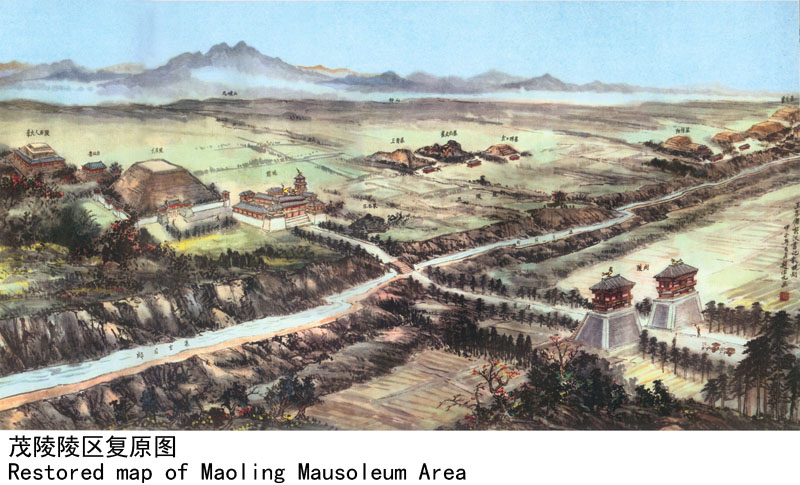第一章 四、茂陵城邑的重要性
王志杰
茂陵城邑是汉都长安最大的重要卫星城。在茂陵陵园东南附近的一部分地区是茂陵邑的遗址,始建于建元二年(前139年)。为了繁荣茂陵的经济,汉武帝不断迁徙众多的文武大臣、豪富、名门定居于茂陵邑。由于人口逐年增加,后改邑为县。《汉书·地理志上·右扶风》:“茂陵,武帝置。户六万一千八十七,人口二十七万七千二百七十七。”建元三年(前138年),对徙居茂陵的人,赐钱20万,赐田2顷。《汉书·武帝纪》:元朔二年(前127年),“又徙郡国豪杰及訾三万以上于茂陵。”太始元年(前96年),“徙郡国吏民豪杰于茂陵”。
陕西省著名文物考古学家武伯纶先生曾分析道:西汉时期徙关东豪族以奉陵邑,长陵、茂陵各1万户,另有三陵各5000户。试以1户5口人计,万户则有5万人之多,所耗费用和牵涉的人力之巨难以估计,加上司事的臣僚和司仪的宫女,总计陵邑人口实属可观。特别是邑内多为富户豪族,迁来后的享用所需,方面极广,各行汇集,造成陵邑的繁荣。其纨绔子弟,斗鸡走马,横行霸道,为所欲为,所谓“五陵公子”、“五陵少年”,遂成为这类人等的同义语了。
在今陕西省兴平市南位镇道常村东沟以西,武帝茂陵白鹤馆遗址以东的一片古文化遗存地带,经常发现大量的汉代遗址并有遗物出土,从形制及分布来看,中心范围东西长约1500米,南北宽约700米左右,显然是一座汉代古城邑的残迹。面对着这一片连绵而已无明显起伏的残砖、碎瓦,即使翻开史书,找到相关记载,人们也仍很难相信,这片瓦砾的确是由于天灾人祸,致使广大下层农民大批破产与流亡。政府有关部门虽然三令五申、严刑峻法,又广施赈济,并多次组织贫民移居边郡,但贫富分化依然继续加剧。现在朝廷决定从各郡国迁官僚富族到茂陵,那些豪强和大户们虽然极不情愿却也无可奈何地踏上西迁长安的路途。武帝倒也不小气,一边派飞马快报督促这一支支入关豪富之家,一边派使节传达其授爵以示恩宠的福音。在这种软硬兼施、双管齐下的政策推动下,豪强巨商们大多不敢再延期观望,纷纷拜别祖祠,变卖田产,收拾细软,举家西迁。背着财富和荣耀遭受风吹雨打,总比举门被下狱、全家被抄没要强得多。
在强制迁移豪商大户的政策刺激下,茂陵邑很快发展起来,不久就形成了一个相当规模的重镇,成为汉都长安的重要卫星城市。
汉代的丧葬制度,是汉朝当时现实生活的缩影,它集中反映了当时的礼制。其陵墓制度及其变化,对以后中国历代封建王朝的陵墓设置,有着深远而广泛的影响。
汉代贵族阶级崇尚厚葬,随葬物品数量大种类多。西汉初期,随葬的都是墓主生前使用的各种器物,如陶仓、陶灶以至羊、狗、鸡、鸭等不一而足。但汉代对于商代开始的残酷的人殉制度,严加禁止,使延续了千余年的人殉葬,遂告终止。
汉武帝于后元二年(前87年)驾崩于周至五柞宫,入殡未央宫前殿。《西京杂记》说:“汉帝送死皆珠襦玉匣,匣形如铠甲,连以金缕。”梓棺内,武帝口含玉蝉,身着金缕玉匣。“匣上皆镂为蛟龙鸾凤龟麟之象,世谓为蛟龙玉匣”。茂陵地宫内充满了大量的稀世珍宝,《汉书·贡禹传》说:“武帝弃天下,霍光专事,妄多藏金钱财物,鸟兽鱼鳖牛马虎豹生禽,凡百九十物。”由于武帝在位时间长,年年都有罕见的珍宝藏于墓中,至他死后入葬时,地宫内已塞满宝物,无法再装。《新唐书·虞世南传》载:“武帝历年长久,比葬,陵中不复容物。”
茂陵埋藏珍宝之多,是十分惊人的。据史籍载,连同康居(一说唐渠)国王赠送的玉箱、玉杖和他生前曾经阅读的《杂经》30卷,盛一金箱,也一并埋入墓中,以供他在幽冥中能继续使用。
所谓“金缕玉匣”、“蛟龙玉匣”、“金缕玉衣”,这是一物三名。汉武帝死时身穿的金缕玉衣形制与结构,大致如此描述:玉片的大小、形状,是依照人体各部位相同的形状设计的。玉片之间,以金丝加以编缀。玉衣分为头部、上衣、裤筒、手套及鞋五大部分。是由脸盖、头罩、上衣前后片、左右袖筒、左右手套、左右鞋等共计12部件组成。据说,汉武帝身体高大肥胖,玉衣形体就大。它全长1.88米,以约2498片大小玉片组成,共用金丝重约1100克。
D Importance of Maoling as Township
Maoling Township was the largest satellite city vital to Chang'an,capital of the Han Dynasty(206 B.C.-220 A.D.).Part of the remains of the township lay southeast to the Maoling Mausoleum Area.The township began construction in 2nd year(139 B.C.)of the reign title Jianyuan(140-135 B.C.).Quantities of remains sites and relics belonging to the Han Dynasty were unearthed east to the remains site of the White Crane Pavilion at the Maoling Mausoleum of Emperor Wudi.The central part extended 1500m long west-east and 700m wide north-south.Obviously,it was the remains of an ancient city belonging to the Han.The cause for the remains was due to natural and man-made calamities.The local inhabitants were forced to leave the place for livelihood.In order to revive the local economy,Emperor Wudi decided on immigration from neighboring prefectures.At first,immigration plan was not smooth.Before long,Emperor Wudi implemented series of policies to encourage senior officials,wealthy merchants and reputable families to settle down at Maoling,promising to grant every immigrant fixed amount of money and two hectares of land.Soon,Maoling developed into an important town of considerable scale.
The aristocracy of the Han Dynasty held luxurious burial in esteem,burial objects in large quantities and varieties.Early in the Western Han Dynasty(206 B.C.-25 A.D.),burial objects were the articles used by the deceased,e.g.,pottery barn and pottery kitchen range,in addition to sheep,dog,cock,duck,etc.But in the Han Dynasty,strict ban was imposed on inheritance from the Shang Dynasty(1600-1100 B.C.)at which slaves were taken as companions to be buried alive with their dead masters.
Emperor Wudi died in 2nd year(87 B.C.)of the reign title Houyuan(88-87 B.C.)at the Wuzha Palace.The funeral was held at the Weiyang Palace.In the coffin,the emperor wore jade suit sewn with gold threads and held cicada-shaped jade in mouth.
As is revealed in the historical records,the burial objects in the mausoleum were extremely rich and luxurious including gold and silver wares,stone birds and beasts,apart from the jade cases and the jade sticks given by the King of Kangju State plus 30 volumes of classics read by the emperor,which were all placed in gold case.When the emperor was buried,the mausoleum had‘no more vacant space left to accept any’.
When dead,Emperor wore jade suit sewn with gold threads.Jade pieces were designed in shape of respective parts of his body.The 2498 jade pieces were strung with 1100g gold threads to comprise a face mask,a head cover,a coat,a pair of trouser legs,a pair of sleeves,a pair of gloves and a pair of shoes.

茂陵文物鉴赏图志/王志杰著.—西安:三秦出版社,2012.